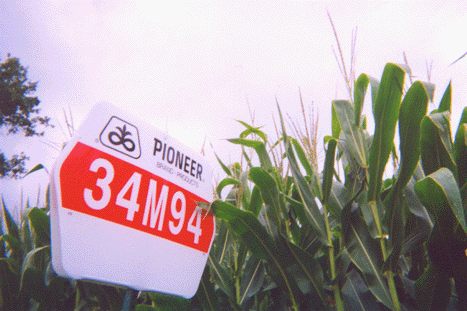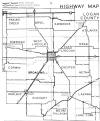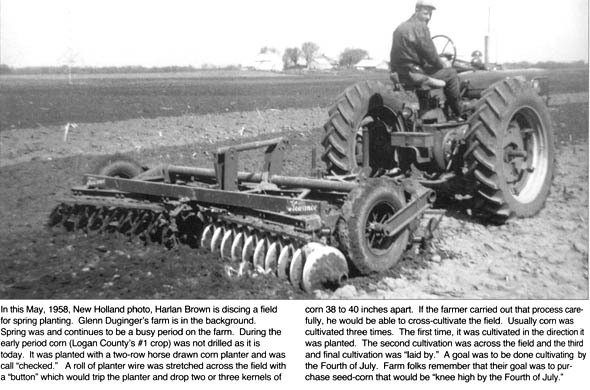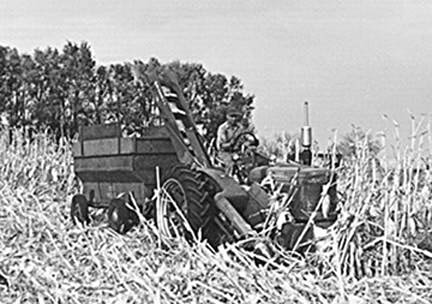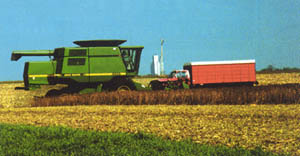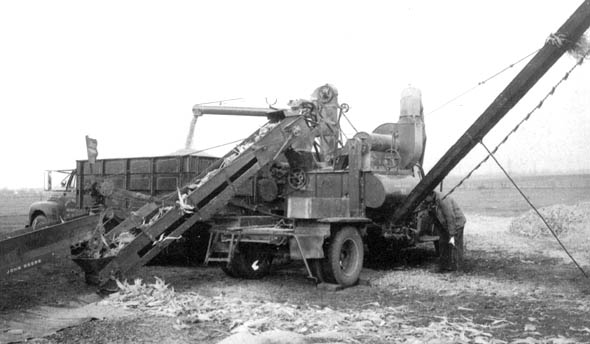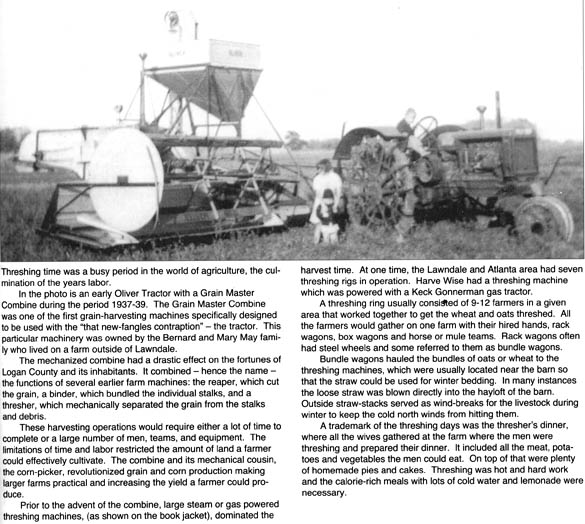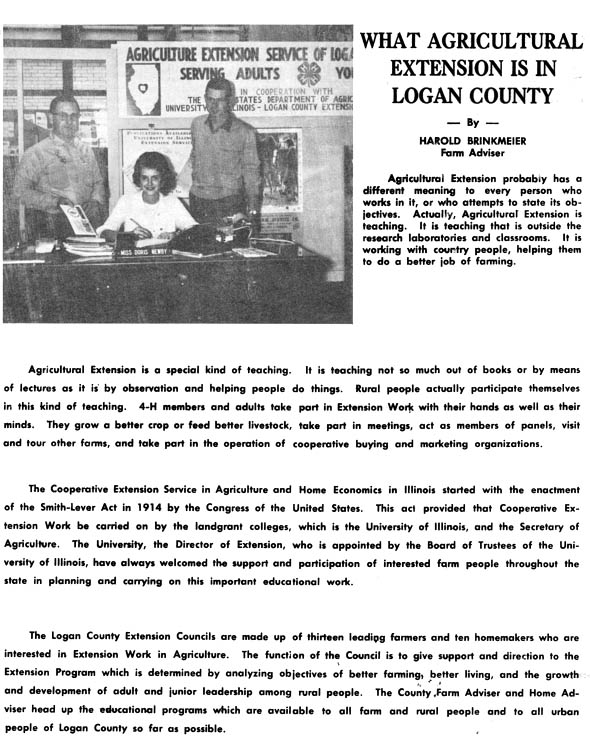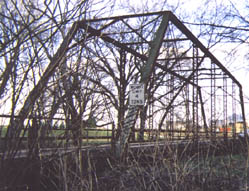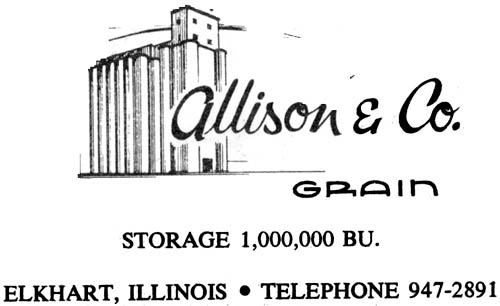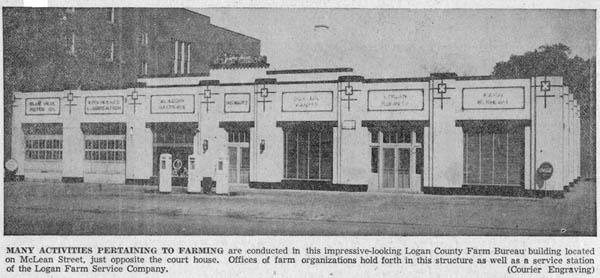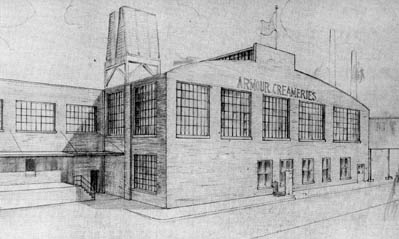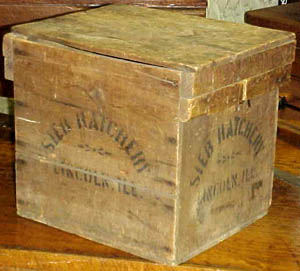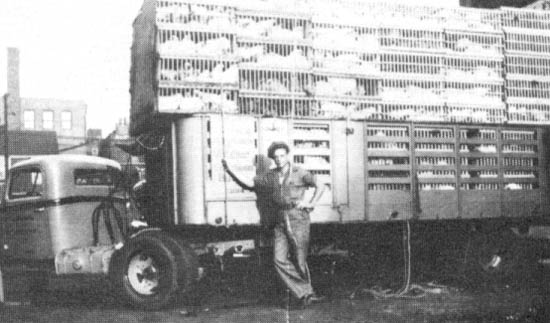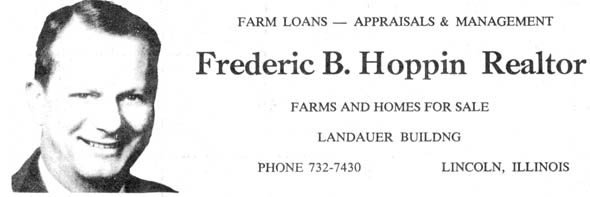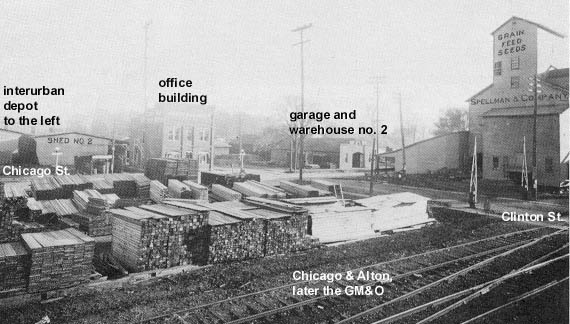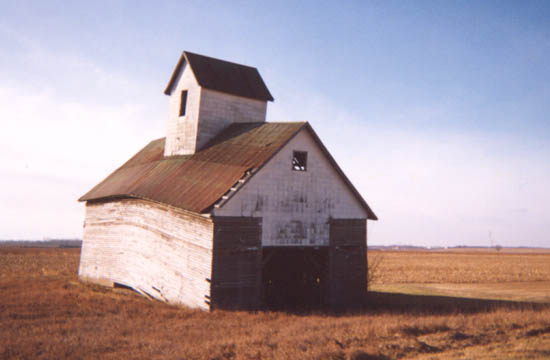
1860 photo taken 4 days after Mr.
Lincoln visited Lincoln, Illinois, for the last time. Info at 3 below.
This President
grew;
His town does too.
Link to Lincoln:
Lincoln & Logan County Development Partnership
Site
Map
Testimonials
Abraham Lincoln Bicentennial Commission of Lincoln, IL
|
Internet Explorer is the only browser that shows this page the way it was
designed. Your computer's settings may alter the display. |
|
April 24, 2004: Awarded "Best Web Site of the Year" by the Illinois State Historical
Society "superior
achievement: serves as a model for the profession and reaches a greater
public." |
|
|
|
Marquee Lights of the Lincoln Theater, est. 1923, Lincoln, Illinois |
|
|
|
17. Agriculture in the Route 66 Era |
|
"Lincoln itself was [is] a farming community, and owed its prosperity to the rich farmland that lay all around it. It was also a place that successful farmers retired to when they were ready to give up farming and spend their declining years at the Elks Club, playing rummy. And there were a certain number of men in Lincoln who, like my father, owned land which they kept a careful eye on and from which they derived a substantial part of or even all of their income."
William Maxwell, Ancestors (1971),
p. 230. |
|
The topics on this page are
▪ Introduction to agriculture in
Logan County, Illinois
17.1: Maturing Corn Crop Along Route 66 Beltline at Lincoln, Illinois (Photo by Leigh Henson, 7-02) Introduction to Agriculture in Logan County, Illinois Logan County, Illinois, contains some of the most fertile land in the world. Thus, farming has shaped Lincoln's growth from the earliest times to the present. Row crop farming, first of corn then of corn and soybeans, emerged as more important than raising livestock. A history of farming in the Lincoln area, including memoirs of 20th-Centuy farmers, appears in Nancy Lawrence Gehlbach's "Farm Life in Logan County, Our Times. She explains how farming changed over the decades, for example, how hedgerows of Osage orange trees were used to help mark boundaries as the land became well populated. Then, hedgerows got in the way of tractors, so the hedgerows were taken out, drastically changing the prairie landscape and destroying the habitat of many species (p. 1). Another excellent history of agriculture in Logan County is found in Paul Gleason and Paul Beaver's Logan County Pictorial History (pp. 1-22). The photos there depict farmers at work and the changing technology of farming, farm houses and farm buildings, the crops, as well the variety and importance of livestock. To me, agriculture means not only farming and supplying materials and services that support farming, but also processing and marketing farm products. The vital relationship of agriculture to the social fabric of this community is described in 4. Introduction to the Social & Economic History of Lincoln, Illinois.
The following highway map also shows the townships and
smaller communities that depended on agriculture. After the map, this
page presents farming activities of Logan County and then a sampling of
various businesses associated with agriculture. These businesses
either supported or depended on farming, and some of them were located in or
near the city of Lincoln. |
|
Route 66 Was the Main Artery in the Heart of Farming Country in Logan County 17.2: Highway Map of Logan County, Illinois, in the Route 66 Era (Map from Official County Plat Book and Farmers' Directory of
Logan County, Illinois, 1962, p. 3. Click on thumbnail for full
image.) |
|
Farming Procedures in the Route 66 Era Discing to Prepare the Soil for Planting
17.3:
Photo from Paul E. Gleason and Paul J. Beaver, Logan County Pictorial
History, p. 182. |
|
Corn Planting In various publications on the history of Lincoln and Logan County, I could not find a photo of corn planting in central Illinois, so on the Web I located the following photo, which shows a corn planting attachment and tractor from mid 20th Century.
17.4: John Deere JDL Tractor (1937-1946) and Corn Planter (Source:
http://johnnypopper.com/cgi-bin/jdstatsf.cgi?L. Link worked on
4-12-03.) |
|
Cultivating
17.5: Cultivating Soybeans and Great Farmer Story in Caption of the Photo (From Gleason and Beaver, Logan County Pictorial
History, p. 182) |
|
Picking Corn
17.6: Picking Corn in 1960 Was the Same in Illinois as Iowa (Source: http://www.lib.iastate.edu/ -- accessed 4-12-03) 17.7: Contemporary Harvest Scene in Logan County, Illinois (Photo
from Lincoln/Logan County Illinois Chamber of Commerce Community Profile
& Membership Directory, p. 29. Photo courtesy of
VillageProfile.com, Elgin, IL.) |
|
Removing Corn from Crib to
Conveyor
17.8: Automated Corn Rake (Photo from Gleason and Beaver, Logan County Pictorial
History, p. 184) |
|
Shelling and Loading Corn
17.9: Corn Moves from Conveyor to Sheller to Truck (Photo from Gleason and Beaver, Logan County Pictorial History, p. 183) The caption for 17.9 says "The 1964 photo illustrates corn shelling on the Harlan and Anne Brown farm in the days before metal storage bins and corn dryers. After the corn was harvested from the field, the ears were put into a corn crib, which was made of wood with gaps between each board, to finish drying. Most of the corn destined to be sold was usually dispersed of during the winter months when prices 'were up.'
At sale-time, a custom corn-shelling crew would come out to the farm, open
the crib, shell the ear corn, and take it to the elevator. Usually the
crew was farmers from the neighborhood. The wives would prepare a
bounteous noon meal as part of the spirit of 'neighbors helping neighbors'"
(p. 183). |
|
Threshing
17.10: Threshing Time on the Bernard May Farm Near Lawndale and Route 66 (Photo and caption from Gleason and Beaver, Logan County Pictorial
History, p. 127) |
|
Agricultural Education
and Outreach 17.11: Progressive Farming in the Route 66 Era Official County Plat Book and Farmers' Directory of
Logan County, Illinois, 1962, p. 43. |
|
19th-Century Bridges in Logan County: Connecting Town and Country |
|
|
17.12:
Foreground Bridge over Gully and Background 1898 Bridge over Sugar Creek |
17.13:
Profile of 1898 Bridge Shown in 17.12 |
|
The photos above and below show rare 19th-century Logan County bridges still in operation as of March, 2004. The bridges above are located about a mile north of the present bridge on old Route 121 between Lincoln and Hartsburg near Tom's Lodge (bar and grill previously known first as Hutton's Lodge and then Lonnie and Mae's in the Route 66 era. Hutton's Lodge was allegedly frequented by the Al Capone crowd, but that's another story). The photo below left shows evidence of a serious accident, but apparently not enough structural damage was done to close the bridge. On both ends of the bridge, metal plates are mounted high in the center of the top cross bars-- plates mounted too high for vandals and thieves to reach. The identical metal plates read 1898 M M Kendrick Built by The bridge shown below at
the right is just east of Camp Griesheim, a Girl Scout camp in the Route 66
era that was located a couple of miles east of Nicholson Road north of
Lincoln (the camp is still there but no longer used as a Girl Scout camp). A
sign on the narrow gravel road leading to this bridge from the west says the
road is not maintained by the county. The bridge is still being used, but I
am unsure how it is maintained if the county does not keep up the road. This bridge has no
identifying information on it. I took these photos in the third week of
March, 2004. |
|
|
17.14: Hole
in Bridge Shown in 17.13 |
17.15:
Sugar Creek Bridge |
|
The early 20th-century scene below occurred in the area of the bridge in 17.15. Fred Blanford emailed the photo, provided by Larry "Jughead" Malerich, and Fred offers the following account: "Today's pic
is another in the JugScan series. It was described to him as being of a
camp town summer retreat by relatives or friends of relatives--and his
memory was that he was told the campground was north of town just off
Nicholson Road. When he mentioned this--I had a couple of glimmers of such
a place from very distant youth--and at least one of a more modern time. I
went to a 'black powder meet' at a similar place out north in Eminence
Township in the mid-60's. Many of the participants were "camping" then. I
am not able to recall a specific location for this particular campground but
do recall it to have been some of the less flat (crop-able) ground in Logan
County--which means pretty much--Eminence Township. Camp Griesheim and Gold
Springs are located in Eminence Township--as is Union--from whence the Union
Street (nee Road) name. Leigh's note: Nicholson Road runs north of Lincoln toward Union, Illinois, and Route 136, which is just a couple of miles north of Union. Route 136 runs east/west between Havana and McLean. The old interurban (electric railroad) alignment parallels Nicholson Road. The rail alignment ran north toward Union and Mackinaw, Illinois, then on toward Peoria. Gold Springs, a 19th-century spring located in this part of Logan County, was noted for its pure waters, attracting many from near and far. A small hotel accommodated Gold Springs patrons. Just northwest of Gold Springs are several acres of heavy brush and woods donated by the late Brewster Parker to the state of Illinois for exclusive use as a game preserve. As Fred notes, folks must have retreated to this cool forested canopy to escape the burning summer sun, just as they escaped to the wooded Chautauqua grounds west of Lincoln. Of course, "fire and brimstone" preachers sometimes worked up audiences into a feverish frenzy.
17.16: Camp Town of August, 1915, North of Lincoln Near Nicholson Road (Photo provided by Larry
"Jughead" Malerich and emailed by Fred Blanford, both LCHS Class of 1959) |
|
|
Grain Elevators
17.17:
Display Ad in Official County Plat Book and Farmers' Directory, 1962,
p. 18. |
|
|
17.18: Display Ad in Official County Plat Book, p. 16.
The East Lincoln Farmers Grain Company Kruger Elevator was located just
north of Lincoln on Route 66. A large photo of the Kruger Elevator,
provided by Fred Blanford, appears at the bottom of the page on
8.
Route 66 Overview Map of Lincoln with 42 Sites, Descriptions, & Photos. |
|
|
The Logan County Farm Bureau
17.19: Logan County Farm Bureau Building on the Courthouse Square (Photo from Lincoln Evening Courier, Centennial
Edition, Section Six, August 26, 1953, p. 14) |
|
|
Logan Farm
Service Co.
17.20: Display Ad from
Official County Plat Book, p. 12. |
|
|
Meat Processing
17.21:
Display Ad from Official Plat Book, p. 26. |
|
|
Poultry Operations Poultry operations were important to the economy of Lincoln and Logan County, Illinois, in the 20th Century. Several of these businesses are describe below. Another poultry operation was the Mapleside Poultry Farm and Hatchery.
17.22: Drawing from Armour's Full-Page
Ad in the The ad says the drawing shows how the facility would look after remodeling and the addition of a second story. Armour's provided chickens, eggs, butter, and cream to food suppliers. "The new Armour Creameries will have the facilities to process completely between 18,000 and 20,000 chickens a day. Back in 1924, when Armour opened its first plant in Lincoln [purchased from Les Atlass, founder of WBBM], about 4,000 chickens a day were processed." The ad says "chickens we process now are table dressed, fresh iced and rushed to food stores the very same day." Sieb's Hatchery Sieb's Hatchery (1914-1972) grew from Albert Sieb's basement into
a major Lincoln industry, including a "chicken ranch" on partner Frank
Dumser's farm on Primm Road. Dumser was in charge of marketing four
million chicks per year. Junior partner John Schrauf was in charge of
"directing scientific feeding of two to three thousand White Leghorn layers
and the raising of twice that number of chickens in order to keep the laying
flock replenished" (Beaver, p. 56). |
|
|
17.23: Sieb's Hatchery Shipping Box Each laying hen had a leg band showing it met state requirements. "Hens failing to come up to the standard had their tail feathers clipped and were sold before the next culling" (Beaver, p. 56). Sieb's shipped baby chicks to every state, but Wisconsin and Illinois were the main markets. "The baby chicks were carefully packed in well made pasteboard containers to suit size of shipment and distances they were to travel. |
17.24: Sieb's Catalog, 1943
Sieb's paid "upwards of $50,000 to the farmer for eggs alone during one
season" (Beaver, p. 56) |
|
None but good strong, healthy certified chicks,
guaranteed to be true to name, full count, free from diseases and 100
percent live on delivery were shipped in advance" (Beaver, p. 56).
17.25: Merritt Stoll with 1935 Tractor-Trailer (Photo from Paul Beaver, Logan County History 1982,
p. 52) |
|
|
Real Estate
17.26: Ad from Official
Plat Book, p. 16 |
| Seeds and
Feeds Tony Bersch & Son
17.27:
Ad from Official Plat Book, p. 18 |
|
|
Fuller Seed According to Paul Beaver's Logan County History 1982, "the Fuller Seed Company was founded in Lincoln, Illinois, in 1936 by Frank Fuller" (p. 615). Mr. Fuller (1889-1957) had been a farm advisor in Marshall and Putnam Counties before beginning first business in Bloomington and then moving to Lincoln. Mr. Fuller anticipated that corn hybrids would boost profitability. Friends in this business, including Lester Pfister, advised him to begin operations in Logan County, and Mr. Fuller knew the farming conditions in this area well.
Around 1940, the Fuller Seed Company moved a few blocks
north of where it had begun on Limit Street. "In the 1950s, as the use of
fertilizers and chemicals began to gain general acceptance, Fuller Seed became
one of the first major retailers of these products in Logan County (Beaver, p.
615). |
17.28: Fuller Seed Company (Photo from ad in Lincoln Courier, Centennial Edition, Section 8, August 25, 1953, p. 15)
|
|
The company continued to build a tradition of helping farmers achieve more return on their investment. In 1952, Ken Fuller and Ben Courtwright teamed up to produce a world record corn yield at the State School Farm and few miles southwest of Lincoln. The photo of the Fuller Seed plant above appeared in a Courier ad in the 1953 centennial edition. This ad emphasizes that Pfister hybrid corn seed produced the "all-time yield record of Illinois."
Highest yield in Illinois 10-acre contest.
Genuine Pfister hybrids are the only hybrids that have won this Corn King title
twice. Genuine Pfister Hybrids hold the world record of 256.9 bushels per
acre from one acre (alternate planting). The record was made by Ben
Courtwright, Manager, Lincoln State School and Colony Farm, Lincoln, Illinois." |
|
|
Leesman Milling
17.29:
Ad from Official Plat Book, p. 1. |
|
|
Spellman & Company (grain, feed, seeds, and lumber)
17.30: Undated photo from Beaver, Logan County History 1982, p. 139. I have identified items in the photo above from memory, except for the garage and warehouse no. 2; that information comes from Fish's Illustrated Lincoln, 1916. The elevator was demolished in 1965, and the ground was sold (Beaver, p. 532). An ad for Spellman's in the 1953 Centennial Edition of the Lincoln Evening Courier mentions the sale of "pig and hog supplement, pig meal, chick starter, laying mash, and dairy feed" (section two, p. 14). John William Spellman, Sr. (1846-1901) and his younger brother, Edward F. Spellman, had come to Lincoln from Lockport, Illinois, in 1866. For several years, John went to school and worked in various agricultural-related jobs, including the Elliott Flouring Mills and the Milans, Booth & Co. in Beason, where he was a grain buyer (Beaver, p. 532). "In 1884, Jeremiah M. Moloney and John W. Spellman, Sr., established the firm of Spellman and Company in Lincoln. The business deals in grain, feed, lumber and building material. There are 29 employees ("Spellman Company Organized in 1884," Lincoln Evening Courier, centennial edition, section four, August 26, 1953, p. 12). "From 1884 until 1890 the firm was known as Moloney and Spellman. After Mr. Moloney's death, Mr. Spellman carried on under the same name. Then in 1891 it became Spellman and Orton. Still another change took place in 1893 [when] it became Spellman and Orton, and Spitly" (Courier). "Shortly afterward, in 1900 and 1901, Mr. Orton and then Mr. Spellman died. Spellman's widow, Ella J. Spellman and Spitly carried on business as partners until 1909 at which time Spitly sold out and John W. Spellman, Jr., took over management, remaining in that capacity until his death in 1950. (The firm was incorporated as Spellman and Company in 1916.)" ("Spellman Company Organized in 1884," Lincoln Evening Courier, centennial edition, section four, August 26, 1953, p. 12). The
Spellman Company "prospered over the years and branched out into building
materials. At one time the company operated nineteen elevators and
five lumber yards in central Illinois. . . . Following John's death,
the business was continued by Caroline [his wife] and then sold by daughter
Jane following Caroline's death in 1961" (Beaver, p. 532). |
|
Trucking
17.31: From a Display Ad for Westen Trucking Livestock & Grain Official County Plat Book and Farmers' Directory of Logan County, Illinois, 1962, p. 6. The photo above shows a grain truck in the foreground and a livestock truck in the background.
17.32: Ad from Official
Plat Book, p. 26 |
|
Memoir of Farms and Farm Work I'm sure the first time I ever set foot on farm land I was following my dad as he walked along a creek bank to fish, as he did a couple of times a week in the late 1940s and early 1950s. I remember walking along all the creeks in Logan County with him: Salt Creek and its tributary, Lake Fork; Sugar Creek; and Kickapoo Creek. Sometimes as we were walking along he would stop when a snake was lying in our path. He liked to tease snakes by slowly touching them on their heads with his fishing rod tip until they bolted. At those times, I stood close behind him. Like many other people who lived in town, some in my family knew farm folks or were related to them (only "one degree of separation," not six). When I was about six or seven, my Uncle Marvin Leesman and Aunt Lois took me on a couple of visits to the farm of his parents, Joseph and Frances Leesman, who lived a few miles east of Hartsburg. Marvin and his brothers--Raymond, Wilbur, and Lawrence-- had grown up on this family farm, and I was excited by each visit there. I was impressed by the largeness of everything I saw: the house, its kitchen, and especially the barn, where for the first time I saw how cows were milked. For 42 years, Joseph and Frances Leesman had farmed a Scully lease (Beaver, History of Logan County 1982, p. 394). A couple of years ago Marvin told me that nothing of his parents' home remains: the exact location has disappeared into fields of crops. When I was about 9 and 10 (approximately 1951), I visited the farm of the Bernard Mays, who lived near Lawndale, located on Route 66 north of Lincoln. The Mays' daughter, Mary, had wed my Uncle Gib Wilson. At the Mays' farm I got a close look at tractors and other machines that seemed strange and complicated (for example, see some of the Mays' farm equipment in 17.10 above). I was also impressed with the Mays' large farmhouse. I was pleasantly surprised to see a photo of it in Gleason and Beaver's Logan County Pictorial History (2000) on page 128:
17.33: The Bernard Mays' Farmhouse Near Lawndale, Illinois I can never think of my Uncle Gib without recalling the time when I was with him, my mother, and some others in the family as we took a drive in the country. I was only about six or seven. For some reason, we stopped, and Gib climbed over a fence and walked toward a tree in a pasture. A bull appeared and became belligerent. I was very much afraid that Uncle Gib was not going to make it back to the car. Like many teen guys, I sometimes earned spending money during the summer with occasional farm work. Many of my contemporaries, including gals, detasseled corn, although I never did. My farm work was mainly baling hay and "shelling corn." For anecdotes about teen townies detasseling and doing other farm work, see Cousin Jerry Gibson's Web site at Jerry Gibson's Lincoln, Illinois, Memoirs & Other Stories. I got jobs on the farm through the guys I ran around with. My pals' favorite hangout was Dial's Texaco Station, located on Business Route 66 (Fifth and Union Streets). A farmer might drop in there or call to announce available work, or one of the guys might otherwise get word of work and recruit the necessary number of "hands" from whoever might be hanging out and willing. I got several baling jobs east of Lincoln through friend Jim McCubbin and his dad. Another one of our gang was Ronnie Miller, and his uncle and father, J. Fred Miller, farmed west of Lincoln and did custom baling. Most of the baling jobs I got were from the Millers. Baling hay was convenient work because it did not begin until mid-day, so there was no need for early rising. By late a.m., several guys had gathered at Dial's, eagerly waiting for word of work. The morning sun was required to dry the hay, which was often cut the day before. Baling wet hay was carefully avoided. Somehow if hay were stored in a barn, months later it could result in spontaneous combustion. I used to hear the Millers explain that old-time farmers would sometimes sprinkle salt on hay to absorb moisture, trying to prevent disastrous fires. Baling hay in those days meant guys stood on the hay wagon behind the baler pulled by a tractor. Often, two guys "rode the rack": one was experienced and taught a newbie. When a bale came off the shoot, a guy would snag it with a baling hook, drag the bale onto the wagon, and quickly stack it in place (working from back of the wagon to front). Usually the pace was quick, requiring someone to stack fast and return to the front of the wagon just in time to grab the next bale. Guys on the wagon would be humiliated if a bale fell off and halted the operation. The pace had to be maintained even when a guy encountered a writhing snake caught in the bale. Bales were positioned and stacked in certain patterns to keep them in place as the wagon bounced and lurched over the rolling field. I cannot recall exactly how many rows high the bales were stacked -- about 7 or 8 rows high or more --; the rows were high enough that bales had to be thrown a couple of feet overhead to form the top rows. As the rows grew higher and higher and close to the front of the wagon, there was room for only one guy, so the other guy climbed on top, stabbing and placing bales to "tie" the rick. The bales were about 4 feet long and could weigh more than 40 pounds, so handling them was strenuous, especially in the blistering heat and wilting humidity of central Illinois. Like others who became experienced enough, I sometimes "rode the rack" alone. Usually a separate crew consisting of two, three, or four guys worked at the barn where the hay was stored. Once a full wagon was taken to the barn, hay would be lifted to the loft either several at a time by ropes and pulleys or sent one by one on a conveyor. Stacking in the barn often required more than two guys because the distances were greater and the rows much higher than on the hay wagon. Baling hay did not pay a lot, but there were other rewards. I remember earning one cent per bale, and I was happy with days that saw 1,000 bales because that meant I had earned $10.00! Guys who baled hay were very tired at the end of the day, feeling relief and a sense of physical accomplishment that made us think we were men. The work was hard, but the experience was fun because we could banter and inflict practical jokes on one another (again, see Cousin Jerry's stories at Jerry Gibson's Lincoln, Illinois, Memoirs & Other Stories). Sometimes the refreshments were great. When I worked for the Millers, the end of the work day was truly "Miller time." When I worked for George White, the women of the family prepared lavish picnic lunches set out on tables with tablecloths. Nothing stronger than lemonade was ever served there, but no one ever left thirsty, either. In July of 2003, the landmark vintage barn of the George and John White families fell victim to progress. See the Courier story at http://www.lincolncourier.com/news/03/07/15/c.asp.
Shelling corn was the only other farm work I ever did, and I did not do very
much of it. I remember working on the Donald Werth farm east of
Lincoln on Route 121 toward Mt. Pulaski (Don Werth's oldest son, Tom, was a
fellow member of the LCHS Class of 1960, and I also knew Frank and Fred, but
Mark then was too young a kid to work with us). This work was a bit
easier than baling hay and usually involved climbing into a corn crib to
rake and push the corn down to the bottom. |
|
17.34:
Ancient Corn Crib Gradually Being Reclaimed by Nature in West Lincoln |
|
Sources Cited and Suggested Beaver, Paul J. History of Logan County Illinois 1982. Published by the Logan County Heritage Foundation. Dallas, TX: Taylor Publishing Company, 1982. The following are found in Mr. Beaver's book: · A brief history of the Logan County Fair Association and the Logan County 4-H Clubs, pp. 43-44. · "History of Logan County Homemakers Extension Association," p. 45. · Black and white photos titled "Logan County Agriculture," including photos of combining, butchering, threshing, mules and wagon, pp. 48-49. · Biographical and autobiographical sketches of many farm families and photos of farms Histories of farm-related companies: Beaver, Paul J. William Scully and the
Scully Estates of Logan County, Illinois. Normal, IL: Gehlbach, Nancy Lawrence. "Farm Life in Logan County." Our Times. vol. 2, no. 2, summer, 1997. Prairie Years Press. 121 N. Kickapoo Street, Lincoln, IL 62656. · Articles on the coming of electricity to farms in the area, the Scully Estates, Harold Apel's and Rosemary Apel's recollections, and the Logan County Fair Gehlbach, Nancy Lawrence. "Tough Times for Farmers. . . Miners." Our Times. vol. 4, no. 1, spring, 1999. Prairie Years Press. 121 N. Kickapoo Street, Lincoln, IL 62656. · Personal recollections of the challenges faced by farmers and miners during the Depression Gehlbach, Nancy Lawrence. "Down on the (Dairy) Farm. Our Times. vol. 5, no. 2. summer, 2000, pp. 6-7. Prairie Years Press. 121 N. Kickapoo Street, Lincoln, IL 62656. · Personal recollections of three farm couples: the Irwins, the Rankins, and the Stolls Gleason, Paul E. Lincoln: A Pictorial History. St. Louis, MO: G. Bradley Publishing, 1998. · "Agriculture 1850-1900": statistics about acres farmed and crop yields; the role of poultry on the family farm; history of Irvin Schroeder family farm; eight black-and-white photos, including work horses, pp. 44-46. · "William Scully," p. 47. · "Logan County Fair," pp. 156-161 Material from Mr. Gleason's books is copyrighted with all rights reserved. Mr. Gleason's material used in this Web site is with permission from the G. Bradley Publishing Company, 461 Des Peres Road, St. Louis, MO 63131. Call 1-800-966-5120 to inquire about purchasing Lincoln: A Pictorial History (1998) (200 pages of rare photos and text) or Logan County Pictorial History (2000) (also 200 pages of rare photos and text). Visit http://gbradleypublishing.com/. Gleason, Paul E., and Paul J. Beaver, Logan County, Illinois: A Pictorial History. St. Louis, MO: G. Bradley Publishing, 2000. · "Agriculture in 1850," pp. 10-22. · Summaries of farming communities' histories throughout Logan County, with photos and captions describing many farms, farm families, schools, businesses, and churches "Landlordism." History of Logan County, Illinois. Chicago, IL: Inter-State Publishing Co., 1886. This material cites the tenant-farming practices of John D. Gillett, father-in-law of Governor Richard J. Oglesby, and of William Scully. This account praises Gillett and criticizes Scully for the terms required of their tenants. (Bob Goebel acquainted me with this information.) Lincoln/Logan County Chamber of Commerce Community Profile & Membership Directory, 1998. Photo courtesy of Village Profile.com, Inc., 33 N. Geneva Street, Elgin, IL 60120. Please visit the Web site of this remarkable company at http://www.villageprofile.com. Lincoln Evening Courier, Centennial Edition, Wednesday, August 27, 1953. · Brief article on the founding of the Logan County Fair, p. 6 · "William Scully Was Land Baron of Midwest States," section 5, p. 2. · Article titled "Tall Grain Elevators Add to Architecture of State," section 2, p. 15. · Full page titled "Logan County Soil Is Rated Among Nation's Finest," Section 6, p. 6 · Full page titled "Farming Plays Key Role in Community Economy," Section 6, p. 7 · Various full page ads of creameries and farm implement dealers Lincoln/Logan County Chamber of Commerce Community Profile & Membership Directory, published by Village Profile, Inc., Elgin, IL. Official County Plat Book and Farmers' Directory of Logan County, Illinois, 1962. Mankato, MN: no publisher given, 1962. Stringer, Lawrence B. History of Logan County, Illinois, 1911. Evansville, IN: UNIGRAPHIC, INC., 1978. ·
Chapter 30: "Agricultural," pp. 528-537.
A brief chapter with crop statistics from 1840 to 1910. Also
information about farmer's organizations and fairs. |
|
|
|
"The Past Is But the Prelude" |
|
|
|
|

